
American postcard. Photo: Lloyd Hughes in Scars of Jealousy (Lambert Hillyer, 1923).
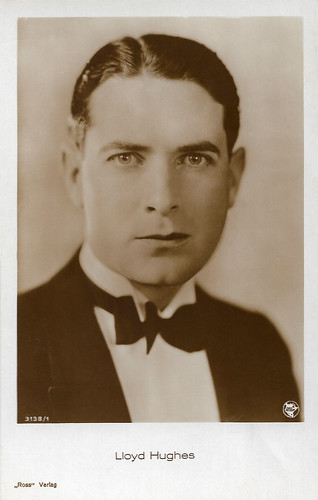
German postcard by Ross Verlag, no. 3138/1, 1928-1929. Photo: First National / Defina.
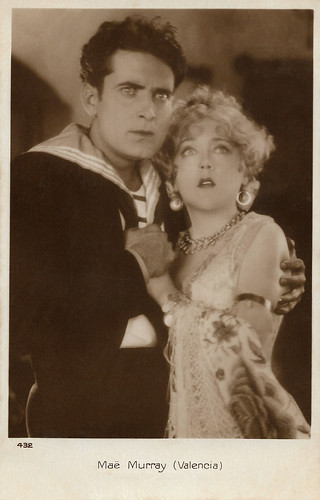
French postcard, no. 432. Mae Murray and Lloyd Hughes in the American silent film Valencia (Dimitri Buchowetzki, 1926).

French postcard by Cinémagazine-Edition, Paris, no. 358. Photo: Evans, L.A.

Austrian postcard by Iris-Verlag, no. 5608. Photo: First National Film.
The Sea Hawk
Lloyd Hughes was born in Bisbee, Arizona, in 1897. Hughes received his education at the Los Angeles Polytechnic School.
He sought a career as an actor early in life, and one of his first film appearances was a bit part in the silent drama Old Wives for New (Cecil B. DeMille, 1918). His clean-cut appearance and acting ability soon gained him recognition. he had bigger roles in The Turn in the Road (King Cidor, 1919), The Haunted Bedroom (Fred Niblo, 1919), and The Virtuous Thief (Fred Niblo, 1919) with Enid Bennett.
His first role as a leading man was in Dangerous Hours (Fred Niblo, 1919), which tells the story of an attempted Russian infiltration of the American industry. He had his breakthrough opposite Mary Pickford in the melodrama Tess of the Storm Country (John S. Robertson, 1921). Other roles included Love Never Dies (King Vidor, 1921) opposite Madge Bellamy, Mother o' Mine (Fred Niblo, 1921) with Betty Blythe, and Children of Dust (Frank Borzage, 1923).
A huge success was the adventure film The Sea Hawk (Frank Lloyd, 1924) about an English noble (Milton Sills) sold into slavery who escapes and turns himself into a pirate king. In this screen adaptation of the 1915 Rafael Sabatini novel of the same name, Hughes played his malicious half-brother. When the film was released, the New York Times critic called it: "far and away the best sea story that's yet been done up to that point".
Another success was the silent fantasy The Lost World (Harry O. Hoyt, 1925) adapted from Arthur Conan Doyle's 1912 novel of the same name, and starring Wallace Beery as Professor Challenger. It featured pioneering stop-motion special effects by Willis O'Brien, a forerunner of his work on the original King Kong (1933). Hughes appeared opposite Mae Murray in the romance Valencia (Dimitri Buchowetzki, 1926). The film was another box office hit and the title song, 'Valencia', was the top song in the U.S. for the year. Then followed a series of romantic comedies and dramas with Colleen Moore, Mary Astor, and Billie Dove.
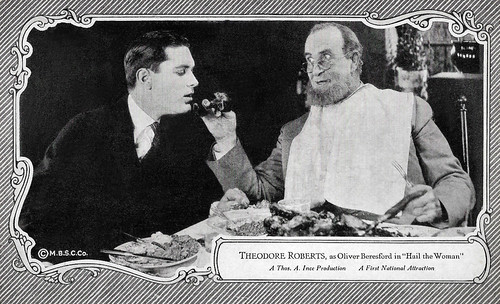
American postcard by Max B. Sheffer Card Co., Chicago (M.B.S.C.Co.), 1922. Photo: First National. Lloyd Hughes (left) and Theodore Roberts as Oliver Beresford in Hail the Woman (Thomas Ince, 1921).
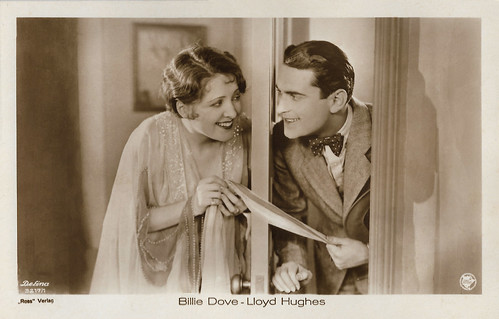
German postcard by Ross Verlag, no. 3217/1, 1928-1929. Photo: Defina / First National. Billie Dove and Lloyd Hughes in An Affair of the Follies (Millard Webb, 1927).

Italian postcard by Casa Editrice Ballerini & Fratini, no. 608. Photo: Metro-Goldwyn-Mayer, Roma. Mae Murray and Lloyd Hughes in Valencia (Dimitri Buchowetzki, 1926).

French postcard by A.N, Paris, no. 36. Photo: Metro-Goldwyn Production. Mae Murray and Lloyd Hughes in Valencia (Dimitri Buchowetzki, 1926).
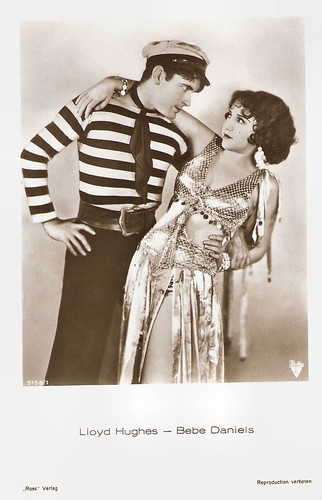
German postcard by Ross Verlag, no. 5158/1, 1930-1931. Photo: Radio Pictures (RKO). Lloyd Hughes and Bebe Daniels in Love Comes Along (Rupert Julian, 1930).
The Mysterious Island
Lloyd Hughes made the transition to sound and worked as an actor through the late 1930s. With Lionel Barrymore, he acted in the Science-Fiction film The Mysterious Island (Lucien Hubbard, 1929) based on Jules Verne's 1874 novel 'L'Île mystérieuse' (The Mysterious Island). It was photographed largely in two-color Technicolor and released by Metro-Goldwyn-Mayer as a part-talkie.
Then he co-starred with John Barrymore in the film, Moby Dick (Lloyd Bacon, 1930), the first adaption film of Herman Melville's 1851 novel 'Moby Dick' which includes a soundtrack.
Hughes had a supporting part in the pre-code drama The Miracle Man (Norman Z. McLeod, 1932) starring Sylvia Sidney.
His films soon became less prestigious. He appeared in B-films like Midnight Phantom (Bernard B. Ray, 1935) by Reliable Pictures and Kelly of the Secret Service (Robert F. Hill, 1936) by Victory Pictures. In Australia, he appeared in a couple of films including the drama The Broken Melody (Ken G. Hall, 1938).
After a supporting part in the adventure film Romance of the Redwoods (Charles Vidor, 1939), his film career was over. Hughes had met his wife, Gloria Hope, on the set of Tess of the Storm Country. The couple had two children: a son, Donald Reid Hughes (1926), and a daughter, Isabel Francies Hughes (1932). Lloyd Hughes died in 1958 in San Gabriel, California. He was 60.
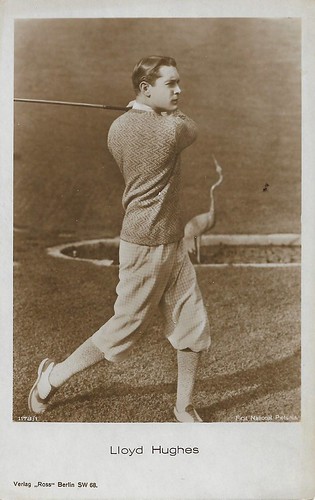
German postcard by Ross Verlag, Berlin, no. 1178/1. Photo: First National Pictures.

German-Italian postcard by Ross Verlag, no. 3069/1. On the back: Ed. Ballerini & Fratini, Firenze. Photo: First National / Fanamet.
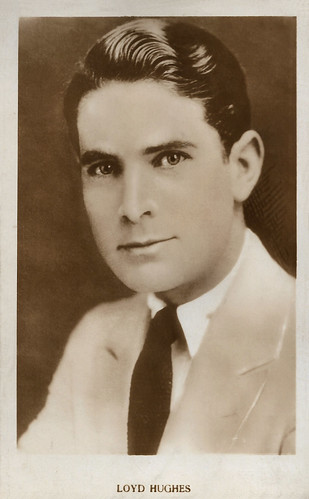
Czech postcard by M. Naki, Praha.
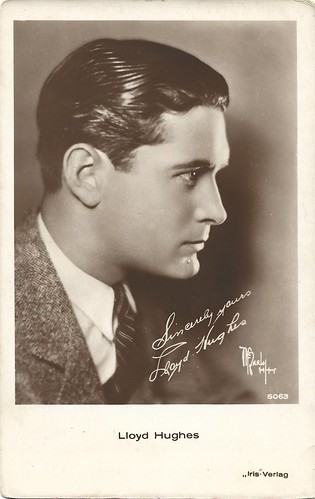
Austrian postcard by Iris Verlag, no. 5063. Photo by Walter Fredrick Seely, Los Angeles. In the 1910s and early 1920s, Seely (1886-1959) was the head photographer for the studio of Albert Witzel, but around 1922 he started his own studio. Trained as a landscape painter, Seely was also an acclaimed painter, who in the last years of his life (1957-59) was the president of the California Art Club. After Seely left Witzel, Max Munn Autrey took over at Witzel's until he started for himself too.
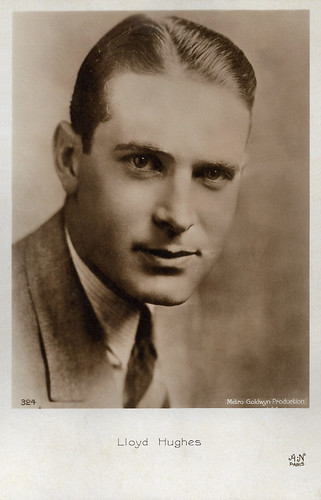
French postcard by A.N., Paris, no. 324. Photo: Metro-Goldwyn-Mayer.
Sources: Wikipedia and IMDb.
No comments:
Post a Comment